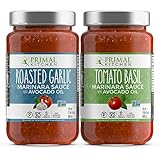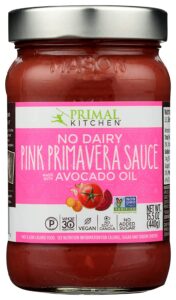Pesto is a thick, green sauce that has a bright and herby taste with a hint of saltiness. It often comes in big jars that people use for pasta dishes, dips, spreads and more. In fact, the jars can be so big that some people have trouble using it all before the best-by date. For this reason, a frequently asked question people have about it is: Does pesto go bad?
Pesto can go bad if not stored properly. Unopened and stored in a cool, dry place away from heat, it can last a few weeks, or even months past the best-by date. Once opened and stored in the refrigerator, it can last 7 to 10 days. If you notice a change in color, smell or if mold appears, it should be discarded.
In this article, we will discuss whether pesto goes bad over time, as well as how to properly store pesto. We will also highlight a few alternatives to pesto. Let’s dig in!
Contents
Does Pesto Go Bad Over Time?
If stored improperly, pesto can go bad over time. To maintain its quality for a longer period of time, keep the sauce in its original container and make sure the container is not damaged. Once opened, make sure the lid is tightly sealed. Pesto should be stored in the refrigerator after opening to maintain its quality.
If you plan on using the entire contents of the jar in a short period of time, the storage method will not make a big difference. However, most people only need a small amount for a recipe, then store the rest away. Therefore, if you are not sure when you will use it next, it is best to store it in the refrigerator to maintain its quality. If you notice a change in color, smell or if mold appears, do not consume and discard immediately.
Does Homemade Pesto Go Bad?
As with store-bought pesto, homemade pesto can also go bad if it is not stored properly. Homemade pesto, however, will most likely go bad quicker than store-bought pesto because there are no preservatives in it. Homemade pesto should always be stored in the refrigerator, and can last around 4 to 5 days.
How Can You Tell If Pesto Has Gone Bad?
There are a few ways to tell if pesto has gone bad.
First, check for mold. If mold has grown on the surface or inside the jar, the sauce should not be consumed and discarded immediately.
Next, smell it. If there is an off or rotten smell, the sauce should not be consumed and discarded immediately.
Lastly, look for a change in color. If the color has changed from green to brown, the sauce should not be consumed and discarded immediately.
If the sauce appears normal and there are no signs of mold, try to remember how long ago it was purchased and how it has been stored. If it has been stored properly, the lid was tightly sealed and the jar is not damaged, then it is most likely safe to consume.
Most jars of pesto will come with a “best-by” date on the label. That is not an expiration date. That is simply a reference for when the sauce will be at its best quality until. Unopened and stored properly in a cool, dry place, pesto can last for weeks or even months past that date.
How To Properly Store Pesto?
If unopened, pesto can be stored in a cool, dry place such as the pantry or kitchen cabinet away from sunlight and other sources of heat. Once opened, pesto should be stored in the refrigerator with the lid tightly sealed.
How To Store Pesto
- Find a cool, dry place such as the pantry or kitchen cabinet away from sunlight and other sources of heat. Heat can affect the quality of the sauce after opening.
- Make sure there is a constant temperature. That means the sauce should be kept away from the stove and dishwasher, and do not keep moving it back and fourth from the refrigerator to the pantry. Keep it in the pantry until you open it, then leave it in the refrigerator.
- Keep the sauce in its original jar. This will prevent any cross-contamination from other jars.
- Once opened, make sure the lid is tightly sealed before storing away in the refrigerator for next time.
Does Pesto Go Bad After Opening?
Once opened, pesto will stay at its best quality for 7 to 10 days in the refrigerator. After 10 days, the sauce should be checked for signs of spoilage before consuming. In order to experience the full taste and quality of pesto, it is best to consume it by the best-by date on the jar and follow proper storage guidelines.
Unopened, pesto can last for weeks or months past the best-by date if stored properly. Once again, proper storage is key when it comes to maintaining the freshness of pesto.
Can You Get Sick From Old Pesto?
Although it will not taste good, eating old pesto most likely will not make you sick. The only time you should be concerned about getting sick from old pesto is when mold develops. Mold can cause allergic reactions, respiratory problems, nausea, vomiting and diarrhea. In rare cases, mold can produce toxic chemicals called mycotoxins that can cause disease and even death depending on the individual and amount consumed.
Alternatives To Pesto
Pesto adds an herby, fresh taste to many dishes. It is known for its bright green color that is often seen in pasta dishes. Although nothing can replace the unique color and flavor of pesto, there are some alternatives you can try instead that may offer a similar flavor profile.
Saratoga Olive Oil Company Basil Infused Olive Oil
 This all natural, gluten-free basil oil features a refreshing green herb taste that works well in a variety of dishes such as salads, breads, pasta and grilled vegetables. If you are looking to take your cooking game to the next level, you have to try this sauce.
This all natural, gluten-free basil oil features a refreshing green herb taste that works well in a variety of dishes such as salads, breads, pasta and grilled vegetables. If you are looking to take your cooking game to the next level, you have to try this sauce.
It is the secret ingredient that will have all of your dinner guests wondering how you made simple recipes taste so good.
Primal Kitchen Tomato Basil Marinara Sauce
 This delicious sauce is made with avocado oil, so you can have your spaghetti without the regret-ti. Although, it is good for much more than just pasta. It adds a fresh taste to pizza, eggplant parmesan, chicken parmesan, meatloaf, and so much more. This sauce is a must-try for your next pasta night.
This delicious sauce is made with avocado oil, so you can have your spaghetti without the regret-ti. Although, it is good for much more than just pasta. It adds a fresh taste to pizza, eggplant parmesan, chicken parmesan, meatloaf, and so much more. This sauce is a must-try for your next pasta night.
Spinelli’s Sauce Co. Cauliflower Alfredo Pasta Sauce
 Spinelli’s is a women-owned small business based out of Colorado, who created this wholesome take on an Italian classic. It is made with no added sugar, artificial flavors, colors or preservatives.
Spinelli’s is a women-owned small business based out of Colorado, who created this wholesome take on an Italian classic. It is made with no added sugar, artificial flavors, colors or preservatives.
Use it to make pasta dishes, chicken dishes, pizza, dips and so much more. No matter how you use it, you are sure to love this guilt-free sauce.
365 by Whole Foods Market Organic Italian Herb Pasta Sauce
 This delicious and herby pasta sauce is suitable for many diets including low-fat, dairy-free, paleo, vegan and vegetarian. Although it is a pasta sauce, it is good for much more than just pasta.
This delicious and herby pasta sauce is suitable for many diets including low-fat, dairy-free, paleo, vegan and vegetarian. Although it is a pasta sauce, it is good for much more than just pasta.
You can use this sauce to make pizza, eggplant parmesan, meatloaf, and so much more. The possibilities are endless with this tasty sauce.
Primal Kitchen No Dairy Pink Primavera Sauce
 Think pink for your next pasta night! This non-dairy sauce is a must-have for all your favorite Italian dishes. It is made with cashew butter for creaminess, carrots for sweetness, beets for an earthy twist, and fennel to add an anise flavor.
Think pink for your next pasta night! This non-dairy sauce is a must-have for all your favorite Italian dishes. It is made with cashew butter for creaminess, carrots for sweetness, beets for an earthy twist, and fennel to add an anise flavor.
Best of all, this sauce is certified paleo and vegan, so people who follow those diets can enjoy it, as well!
Related Questions
Is Pesto Healthy?
As a result of pesto containing ingredients like olive oil, nuts and cheese, pesto can be high in calories and fat. However, pesto also offers a few health benefits such as a reduced risk of heart disease, heart attack, stroke, diabetes, Alzheimer’s, dementia and many types of cancer including breast, stomach, pancreatic and liver. Moderation is key with pesto.
Is Pesto Good For Weight Loss?
Pesto is not ideal for weight loss because it contains ingredients like olive oil, nuts and cheese, all of which can contribute to a fair amount of calories and fat. When trying to lose weight, it is best to stick with foods that are low in calories and fat. Although pesto can be high in calories and fat, it also offers many health benefits, so adding a small amount to your diet will not hurt.
Is Pesto Vegan-Friendly?
Traditional pesto is made with plenty of parmesan cheese, which means pesto is a no-go for those who follow a vegan diet. However, traditional pesto can easily be made vegan by simply replacing the parmesan cheese with nutritional yeast. So, if you follow a vegan diet and are craving pesto, your best bet would be to make it at home. While that may sound like an intimidating task, I promise it is easier than you think.
